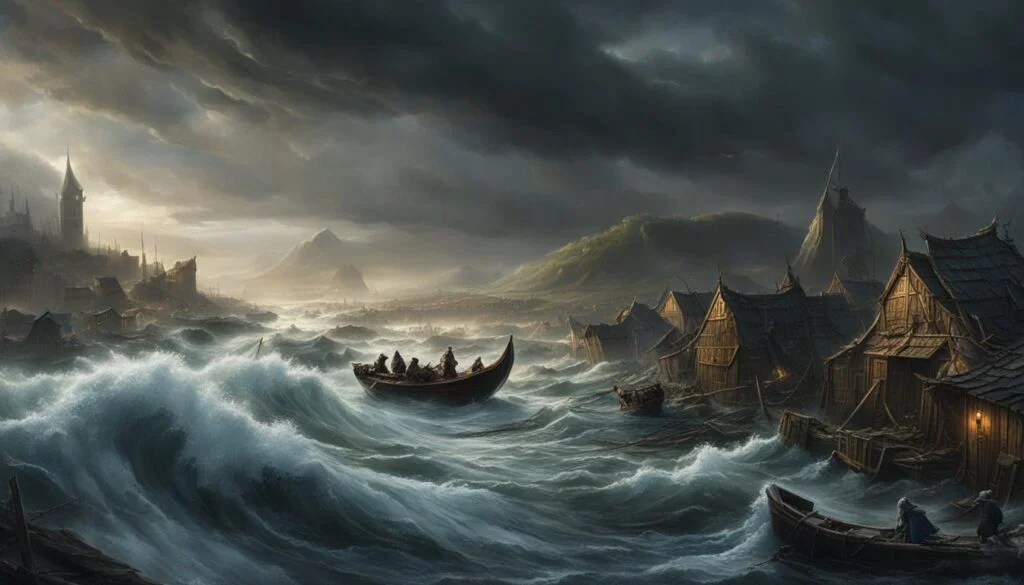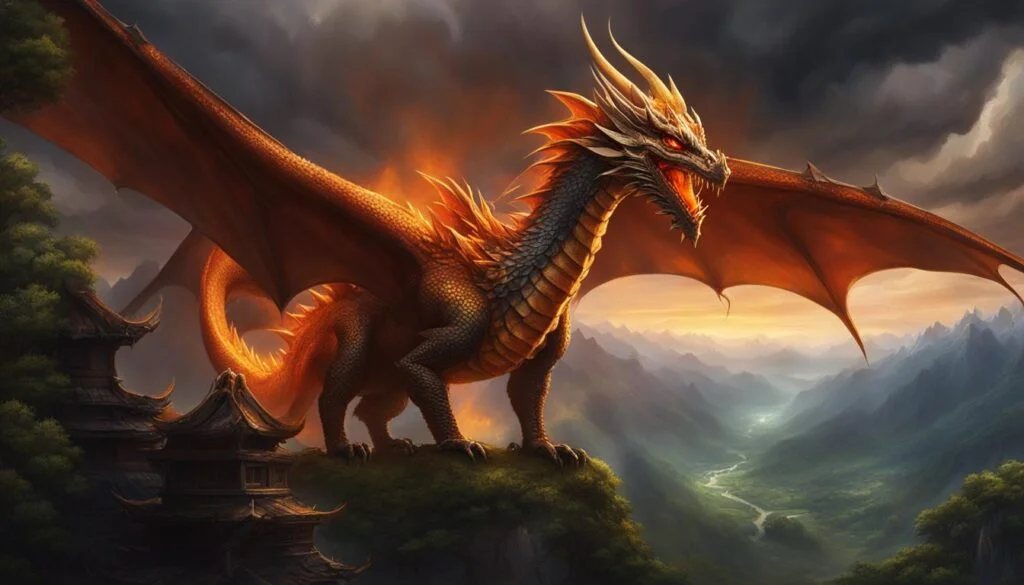In Norse mythology, Bifrost is a captivating and ethereal phenomenon that serves as the bridge connecting the realms of gods and men. Also known as the Rainbow Bridge, Bifrost holds deep significance in Norse religion and mythology, playing a pivotal role in the interplay between different realms and the protection of Asgard, the realm of the gods.
Guarded by the god Heimdall, Bifrost acts as the only passageway for the gods to journey from their divine abode in Asgard to Midgard, the realm inhabited by humans. It is a symbol of the connection between the divine and mortal realms, highlighting the intricate relationship and collaboration between gods and humans in Norse lore.
The meaning of Bifrost stretches beyond its physical presence as a bridge. It serves as a metaphor for the integration of various realms and the harmonious coexistence of gods and humans in the Norse cosmology. Bifrost is often portrayed as a burning rainbow that blazes with flames, mesmerizing all who behold its mystical beauty.
The bridge’s significance is perhaps most profound in the cataclysmic battle of Ragnarok. As the forces of evil converge upon Asgard, Bifrost falls under the weight of the impending doom, signifying the end of an era and the imminent destruction of the gods.
Key Takeaways:
- Bifrost, also known as the Rainbow Bridge, is the ethereal bridge in Norse mythology connecting the realms of gods and humans.
- Guarded by the god Heimdall, Bifrost is the only passage for the gods to travel from Asgard to Midgard.
- Bifrost symbolizes the connection and collaboration between gods and humans, emphasizing their interdependence in Norse mythology.
- The bridge’s destruction during Ragnarok signifies the fall of the gods and the end of an era.
- Bifrost’s legacy extends beyond mythology, as it continues to captivate and inspire in popular culture, serving as a symbol of connection, transcendence, and the enduring allure of Norse lore.
The Cosmic Bridge of Bifrost
https://www.youtube.com/watch?v=vCOWQqRTW2I
In Norse mythology, Bifrost is often referred to as the “best of bridges” and is described as a rainbow that burns with flames. It serves as a connection between the earthly realm, Midgard, and the realm of the gods, Asgard. The bridge is believed to have been built by the gods themselves, demonstrating their exceptional craftsmanship.
However, it is also said to be destined to fall during the apocalyptic battle of Ragnarok, when it collapses under the weight of the forces of evil.
Heimdall: Guardian of Bifrost
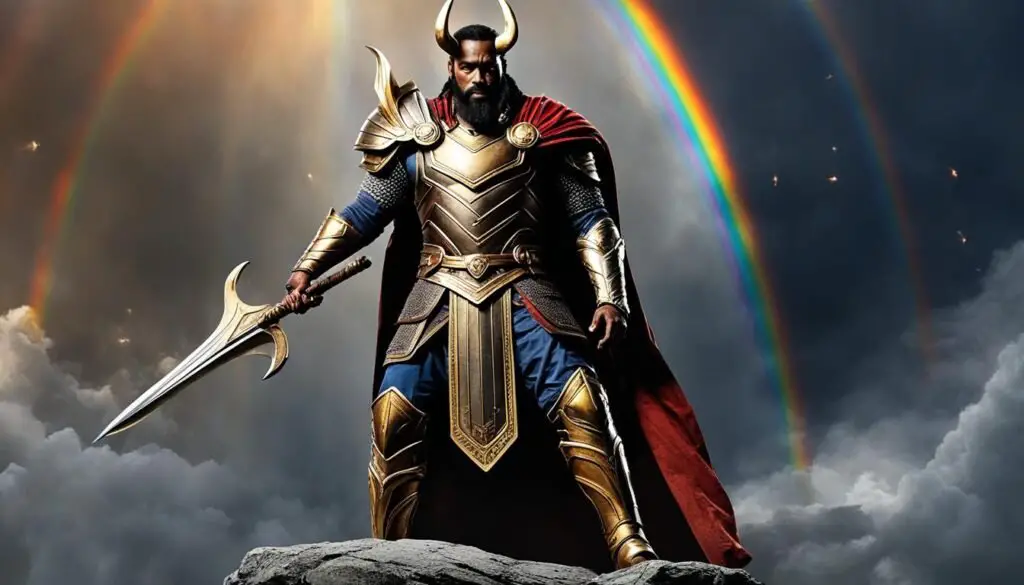
Heimdall, the guardian of Bifrost, is a crucial figure in Norse mythology. Assigned with the task of protecting the ethereal rainbow bridge, he possesses exceptional abilities that make him well-suited for his duty. With heightened senses, he can perceive sights and sounds that others cannot, enabling him to remain vigilant at all times.
As the defender of the bridge, Heimdall plays a vital role in safeguarding Asgard, the realm of the gods, from potential threats. His constant watch over Bifrost ensures the smooth passage of the gods between their home and Midgard, the realm of humans. This duty not only maintains the connection between the realms but also preserves the balance and order within Norse cosmology.
The significance of Heimdall’s role in Norse mythology cannot be understated. His unwavering dedication and exceptional abilities make him the ideal protector of Bifrost. He stands as a formidable guardian, ready to defend the gods and their realm against any potential danger that may arise.
Heimdall and the Protection of Bifrost
- Heimdall’s primary responsibility is to ensure the safety and integrity of Bifrost.
- He stands as the first line of defense, detecting any potential threats that may attempt to cross the bridge.
- With his keen senses, Heimdall can perceive even the faintest disturbances, allowing him to act swiftly and decisively.
- His watchful presence serves as a deterrent to those who would seek to disrupt the peace and harmony of the realms.
The Role of Heimdall in Norse Mythology
Heimdall’s role extends beyond his duty as the guardian of Bifrost. He is also closely associated with the mighty god Thor and is often depicted as a reliable ally and confidant. Heimdall’s keen sight and hearing make him an invaluable asset in Thor’s quests and adventures.
- Heimdall aids Thor in his battles against formidable foes, using his abilities to aid the god of thunder.
- He serves as a source of guidance and wisdom, offering counsel to Thor when needed.
- In some tales, Heimdall even becomes an instrumental figure in the events leading up to Ragnarok, the apocalyptic battle of Norse mythology.
Heimdall’s duty to safeguard Bifrost and his significant role in the Norse pantheon make him a revered and respected god. His unwavering loyalty and exceptional abilities make him an indispensable figure in the intricate tapestry of Norse mythology.
The Significance of Bifrost in Norse Mythology
Bifrost, in Norse mythology, holds great significance as more than just a physical bridge connecting realms. It serves as a powerful symbol of the connection between gods and humans, representing the interaction and cooperation between different realms in the Norse cosmology.
The presence of Bifrost allows the gods to oversee and protect their mortal creations, ensuring the balance between the realms is maintained. It acts as a guardian, defending against the threats posed by the Jotnar, the ice giants who may seek to disrupt the harmony between gods and humans.
Furthermore, Bifrost’s destruction during the apocalyptic battle of Ragnarok carries profound meaning. Its collapse signifies the end of an era and the beginning of a new cycle, emphasizing the cyclical nature of existence in Norse mythology.
This mystical bridge holds immense mystical properties, serving as a passage between different realms and a conduit of divine energy. Its vibrant and burning rainbow appearance embodies the beauty and transcendence found in Norse lore.
Bifrost’s significance permeates the mythology and reaches beyond its physical form, representing the deep connection and relationship between gods and mortals that is central to Norse belief and culture.
Bifrost in the Apocalyptic Battle of Ragnarok
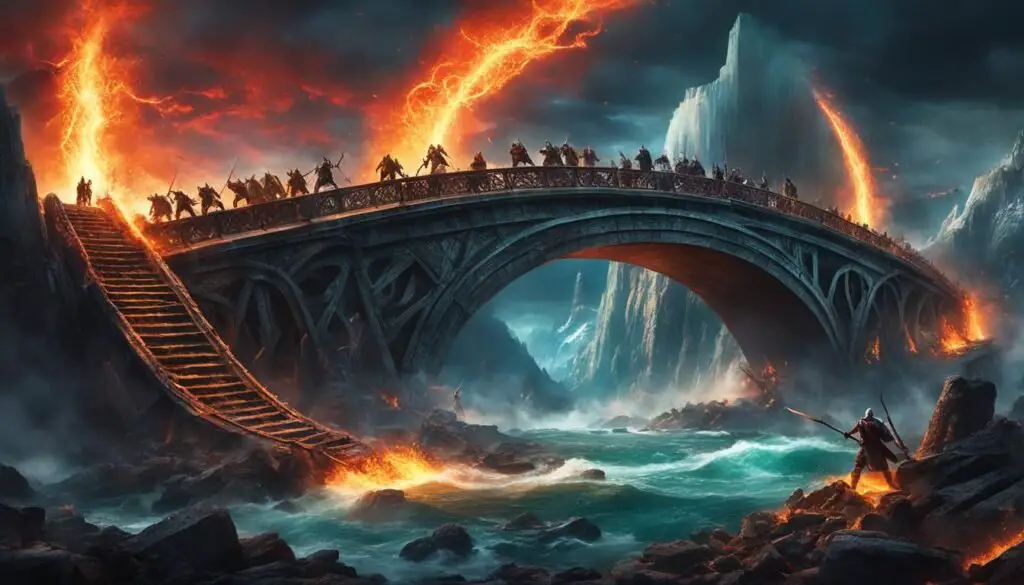
The epic battle of Ragnarok marks the cataclysmic end of Norse mythology. According to prophecy, during this apocalyptic clash, the legendary Bifrost bridge is fated to collapse. This pivotal event in Norse lore is often depicted as the result of the formidable forces of evil, led by the cunning Loki and the powerful Jotnar, overpowering the defenses of Asgard, home of the gods.
The destruction of Bifrost in Ragnarok holds deep symbolic significance. It symbolizes the fall of the gods and the collapse of the existing world order. As the ethereal bridge that connects the realms of gods and humans, its demise marks the end of the harmonious coexistence between these realms. The collapse of Bifrost represents the shattering of cosmic balance and the disruption of the divine connection with mortal beings.
However, despite the catastrophe that Ragnarok brings and the decimation of the Bifrost bridge, there remains a glimmer of hope in Norse mythology. It is believed that from the ashes of this apocalyptic battle, a new world will emerge, signaling the cyclical nature of existence. The destruction of Bifrost paves the way for the birth of an era, where the surviving gods and humans can rebuild and create a renewed cosmic harmony.
The collapse of Bifrost in Ragnarok not only highlights the cataclysmic nature of the final battle, but also emphasizes the transient nature of existence in Norse mythology. It serves as a reminder of the fragility of the divine realm and the inevitability of change. Despite the demise of the Bifrost bridge, its legacy endures in the collective imagination, reminding us of the profound impact it had on ancient Norse beliefs and its enduring relevance in contemporary interpretations of mythology.
Bifrost in Popular Culture and Retellings
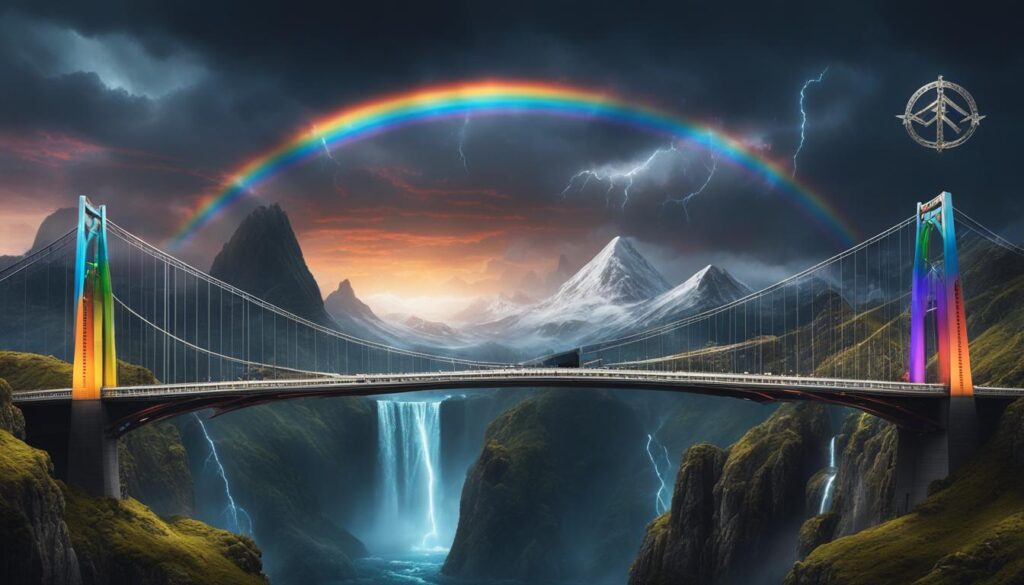
Bifrost, the mythological bridge from Norse mythology, has made its mark in popular culture, captivating audiences in various forms of media. One notable example is its portrayal in Marvel Comics and the Marvel Cinematic Universe.
In these adaptations, Bifrost is often illustrated as a bridge of radiant light or boundless energy, serving as a conduit that links different realms and enables interdimensional travel. The bridge’s portrayal in popular media emphasizes its significance as a symbolic connection between immortal gods and mortal beings. Additionally, its association with the apocalyptic battle of Ragnarok adds depth and intrigue to its depiction.
The Thor movies, part of the Marvel Cinematic Universe, showcase Bifrost as a central element in the storyline. The bridge is depicted as a grand spectacle, with vibrant colors and powerful energy emanating from it. Thor, the God of Thunder, utilizes Bifrost to traverse between realms and undertake heroic adventures.
The representation of Bifrost in modern media not only pays homage to its mythological origins but also expands upon its symbolism and significance. It serves as a visual representation of the connection between different planes of existence, fostering a sense of wonder and awe among audiences.
Overall, Bifrost’s presence in popular culture, particularly in Marvel Comics and the Marvel Cinematic Universe, has propelled its recognition and solidified its status as an iconic symbol of transcendence and interrealm communication.
The Mythological Origins of Bifrost
Much of our knowledge about Bifrost comes from ancient Norse texts, particularly the Poetic Edda and the Prose Edda. These texts describe Bifrost as a burning rainbow bridge, connecting Asgard to Midgard. While details about its construction and origins are scarce, it is believed to have been created by the gods themselves. The mythological origins of Bifrost provide insight into the complex cosmology and beliefs of the Norse people.
Bifrost and the Concept of Predestination

In Norse mythology, Bifrost serves as a symbol of predestination, highlighting the fatalistic worldview of the Norse people. As the guardian of the bridge, Heimdall possesses foreknowledge and is aware of the events that will lead to Bifrost’s eventual destruction during the apocalyptic battle of Ragnarok. This awareness reinforces the belief that the gods and mortals alike are bound by their predetermined fates.
The concept of predestination in Norse mythology emphasizes the cyclical nature of existence, where the unfolding of events follows a predetermined path. The inevitability of Bifrost’s destruction underscores the transience and impermanence of the gods, reinforcing the notion that all things, even the heavenly realms, are subject to eventual demise.
The Legacy of Bifrost in Norse Lore
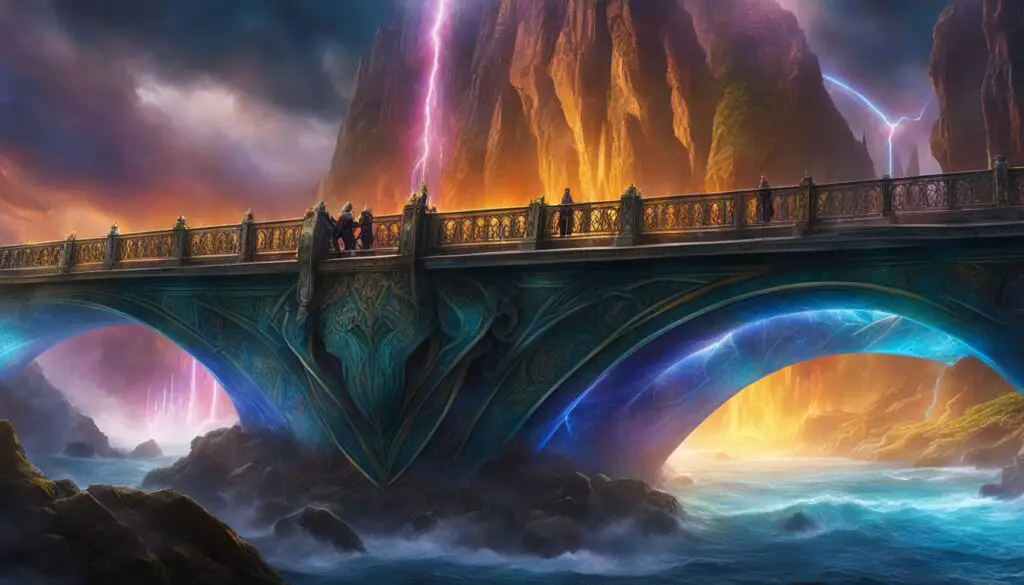
Bifrost’s legacy in Norse mythology transcends its role as a bridge between realms. As the ethereal rainbow bridge connecting Asgard and Midgard, Bifrost holds deep cultural significance and symbolizes the connection between gods and humans.
The concept of Bifrost represents the interplay between different realms and emphasizes the cyclical nature of existence in Norse lore. It serves as a reminder of the importance of vigilance and protection in maintaining the balance between these realms.
Today, Bifrost continues to captivate and inspire in modern interpretations of Norse mythology. It remains a symbol of connection and transcendence, representing the everlasting link between gods and mortals.
The Mythical Bridge that Connects Realms
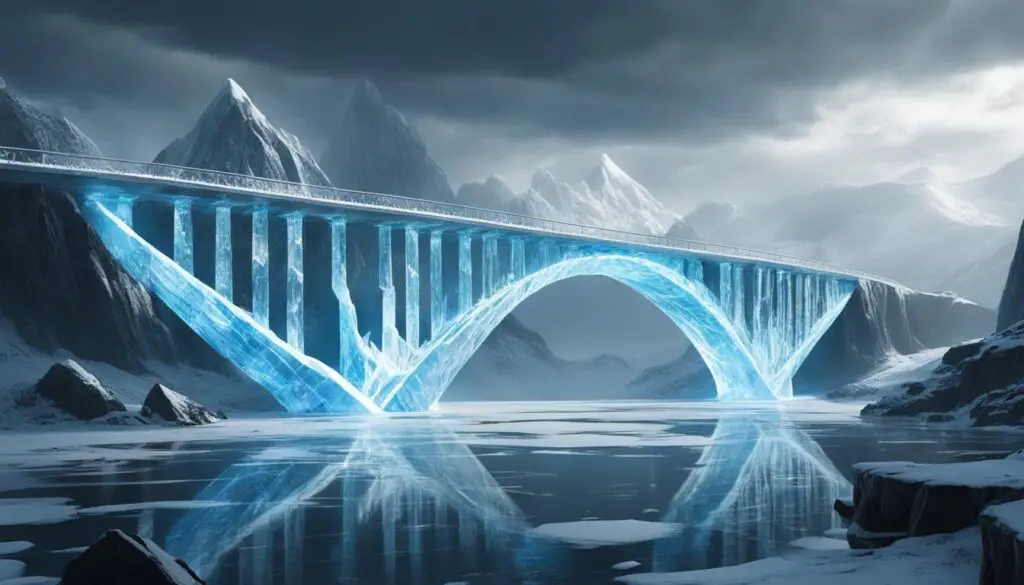
The mythical Bifrost bridge holds a prominent place in Norse cosmology as the bridge that connects the worlds of the gods and humans. It serves as a powerful symbol of the interconnectedness of different realms and the divine influence in mortal affairs. This mythical bridge plays a significant role in bridging the gap between gods and humans, reinforcing the profound importance of their relationship.
Representing the vital link between realms, Bifrost serves as a focal point for interaction and cooperation between gods and humans. It facilitates the exchange of knowledge and protection, strengthening the bond and mutual reliance between these two worlds. The bridge acts as a conduit through which the gods oversee and safeguard their mortal creations.
In Norse cosmology, Bifrost is not merely a physical construction but a testament to the deeper connection between gods and humans. It symbolizes the bridge between the divine and mortal, uniting the realms in a harmonious alliance. This mythical bridge in Norse cosmology underscores the intrinsic relationship between gods and humans, emphasizing their shared destiny and the interdependence of their actions.
In Norse mythology, Bifrost is often depicted as a spectacular rainbow bridge, shimmering with vibrant hues, linking the realm of mortals, Midgard, to Asgard, the home of gods. This enchanting image captures the essence of the bridge’s majesty and the awe-inspiring nature of the gods’ influence on human affairs.
To visualize the mythical Bifrost bridge in Norse cosmology, imagine a stunning rainbow spanning the heavens, radiating with ethereal beauty, and serving as a conduit between the divine and the mortal. This bridge represents not only a physical connection between realms but also a bridge of understanding, mutual respect, and cooperation.
The significance of the Bifrost bridge in Norse mythology extends beyond its physical presence. It highlights the essential role of gods in mortal affairs and the vital connection between the divine and human realms. This mythical bridge serves as a reminder that, despite their differences, gods and humans are interlinked, with their fates intertwined.
As we explore the Norse cosmology, let’s delve deeper into the role and significance of Heimdall, the guardian of Bifrost, in the next section.
Conclusion
Bifrost, the ethereal rainbow bridge in Norse mythology, holds immense significance in the ancient beliefs of the Norse people. As the bridge connecting the realm of gods, Asgard, and the realm of humans, Midgard, Bifrost symbolizes the interconnectedness between gods and humans. It serves as a physical representation of the exchange and cooperation between different realms, allowing the gods to oversee and protect their mortal creations.
Guarded by the god Heimdall, Bifrost plays a crucial role in maintaining the balance between the realms and safeguarding Asgard from potential threats. Heimdall’s extraordinary abilities and vigilance make him the protector of the bridge, ensuring the realms remain secure.
Beyond its mythological significance, Bifrost continues to captivate and inspire in modern popular culture. Its representation in Marvel Comics and the Marvel Cinematic Universe, for example, explore its role as a bridge of light or energy, connecting different dimensions and realms. Its enduring portrayal in various forms of media signifies its ongoing cultural significance and fascination with Norse mythology.
In conclusion, Bifrost embodies the interconnection between gods and humans, the cyclical nature of existence, and the looming destruction foretold in the apocalyptic battle of Ragnarok. As a symbol of connection, transcendence, and the enchanting allure of Norse lore, Bifrost stands as a powerful testament to the rich mythology and beliefs of the Norse people.
FAQ
What is Bifrost in Norse mythology?
Bifrost is the ethereal rainbow bridge that connects the realms of gods and men in Norse mythology.
What is the significance of Bifrost in Norse mythology?
Bifrost represents the connection between gods and humans, the cyclical nature of existence, and the importance of vigilance and protection.
Who is the guardian of Bifrost?
Heimdall is the god assigned the task of guarding the Bifrost bridge.
What is the role of Heimdall in Norse mythology?
Heimdall is responsible for watching over Bifrost and ensuring the safety of Asgard from potential threats.
What is the significance of Bifrost in the apocalyptic battle of Ragnarok?
The collapse of Bifrost during Ragnarok symbolizes the end of the existing world order and the fall of the gods.
How is Bifrost portrayed in popular culture?
Bifrost is often depicted as a bridge of light or energy, connecting different realms and allowing for interdimensional travel.
Where does our knowledge about Bifrost come from?
Our knowledge about Bifrost comes from ancient Norse texts, particularly the Poetic Edda and the Prose Edda.
What does the concept of predestination mean in relation to Bifrost?
The concept of predestination highlights the fatalistic worldview of the Norse people, where the destruction of Bifrost becomes an inevitability.
What is the legacy of Bifrost in Norse mythology?
Bifrost continues to be a symbol of connection, transcendence, and the enduring allure of Norse lore in modern interpretations.
What does Bifrost represent in Norse cosmology?
Bifrost represents the interconnectedness of different realms and the divine influence in mortal affairs.



